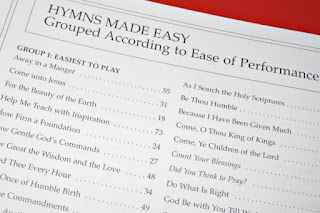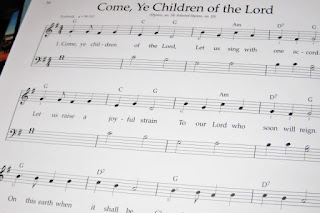The inability to play hymns well after hours of practice can be very frustrating to a beginning organist. In order to provide confident accompaniment for the congregation, a new organist may wish to play one or more hymns or preludes from Hymns Made Easy, the full book of which is also available online.

Hymns are even sorted according to difficulty (page 87).
Examples

"Come Ye Children of the Lord," on page 16, can be played with just the G in the pedals where the bass clef notes split. With a little bit of work, the moving bass line can be added in measures 10 and 12 by playing the A with the right heel, the G with the right toe, and the F# with the left toe.

"There is a Green Hill Far Away," on page 51, can be played simply on the manuals, with the pedal added on the last note.

"High On the Mountain Top," on page 3, can be played using just the E and F in the pedal (the F with the right foot and the E with the left), or in the 8th measure a substitution to the right foot can be made, and the left foot can play the two C's before returning to prelocate the E. In measure 13 the right foot can play G, or not (with the toe, returning to F on the heel). The pick-up to measure 15 and measure 15 can be played with just the manuals, with the pedal re-entering with the right toe on the last note.
As Prelude or Postlude
With the melody line singled out and a very simple accompaniment line, these arrangements lend themselves to a solo and accompaniment registration, which we will cover in more depth in the future. Essentially, the right hand will play on one manual with a more prominent registration, and the left hand will play on the other manual with a softer registration which the pedal balances.
Combining a soft chorus registration for one verse, then changing to a solo and accompaniment registration for a following verse--mixing and matching the two registrations according to the spirit of each hymn--can be an effective way to utilize Hymns Made Easy for prelude or postlude.
In Conclusion

Whether an organist chooses to accompany the congregation from Hymns Made Easy or simply wishes to use them for prelude or postlude, this compilation can be a good resource for beginning ward organists.




;) AWESOME! Thanks!
ReplyDeleteWhat a great idea! I like playing with soloing out melody, but am not great at it yet. I'll grab a few of these and play with it.
ReplyDelete